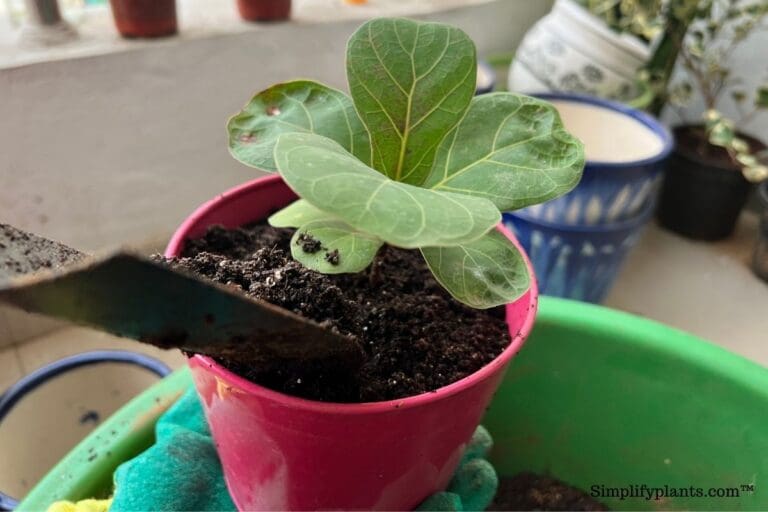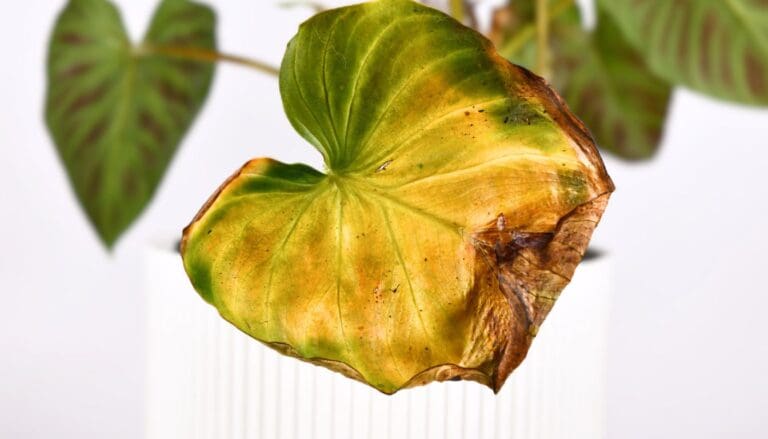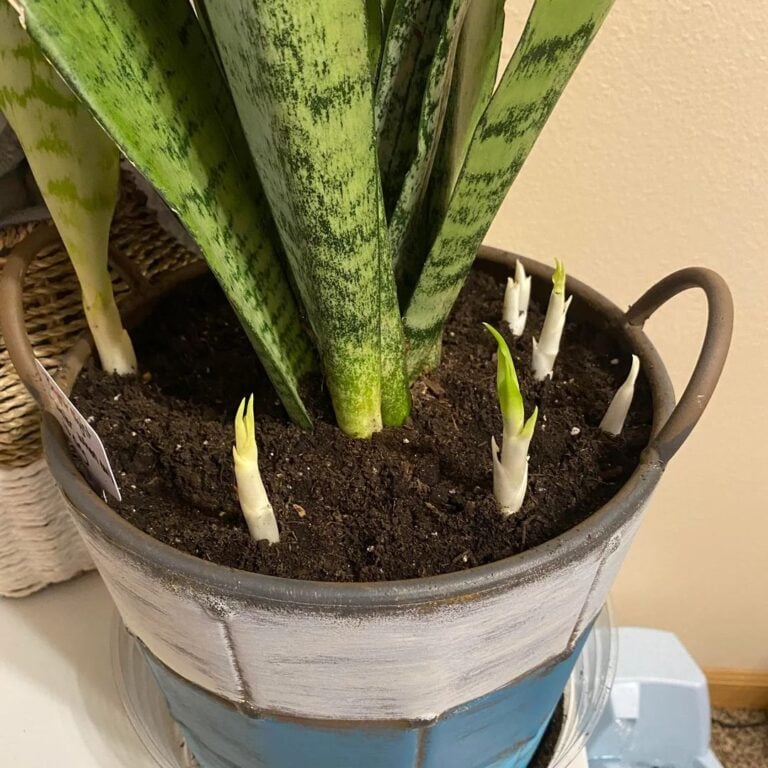Why Is My Snake Plant Dying? (Causes+What To Do)
The snake plant is very popular amongst plant owners, and you might find one variety of snake plants in every plant enthusiast space. But not everyone can keep them alive. Some people often struggle with their snake plant and keeps wondering why is their snake plant dying. So, today let’s learn all about it.
Inadequate watering, root rot, and pest attack are primary problems that lead to a dying snake plant. Most of us tend to overwater our snake plants, especially during the winters, leading to root rot and pest problems that lead to wilting. So, you must always check the soil before watering.
This succulent is also very sturdy and does not give up easily on you. They require minimal care and affection.
It becomes difficult to understand what is wrong with the snake plant because of its nature. However, like any other succulent, they give out certain signs that say what might be wrong with the plant.
In this guide, we will understand the reasons behind the snake plant dying and what can be done to prevent them. Let us get right ahead with it.

Please note: Simplify Plants is reader-supported. Some links in the post are affiliate links and I get a commission from purchases made through links in the post.
Why is my Snake Plant wilting?
Leaves shrinking is one of the most well-known issues for indoor plants. On account of the snake plant, the most common is the root rot issue because of overwatering.
In some cases, we will overlook when to water our plants, and frequently we care for them so much that they begin to kick the bucket.
You probably won’t do that purposely and have just idea about giving the plant somewhat more water, yet the issue emerges when we overwater or submerge the plant in water.
If the plant is overwatered or the roots are made to sit on the water, the plant’s roots may start rotting.
The measure of water that we gracefully add to a plant relies upon the size of the plant. A more modest pot won’t need as much water as the greater pot needs.
When we pick a pot for the Snake plant, we have to ensure that the pot has a decent drainage framework.
The best method of adding water is to feel the soil first. Take your finger or a spoon, dig into the soil up to 2 inches down, and check if the soil is moist.
The Snake plant is succulent; thus, they require less water. Always remember to check the soil first.
During the summer, the snake plant can go without water for about two weeks. We need to reduce the watering around the fall, and during winters, they require significantly less water.
We need a lenient watering regime for the snake plants and must feel the soil before watering the plant.
Even if the topsoil gets dry, the lower layers may retain water; this can prompt overwatering.
Henceforth, we generally propose feeling the soil or using a moisture meter before watering.
Also read: What type of soil is good for snake plant?
Do the leaves have holes or marks?

The Snake plant is disturbed by bugs, which leads to holes and spots in the leaves. Spider mites and mealybugs are attacking the most unsafe part.
The spider mites are white in concealing and feed upon the Snake plant’s new leaves, leaving holes on the leaves.
Thus, if there are holes on your plant, it is no uncertainty attacked by creepy crawly bugs.
Being succulent, they are also prone to get overwatered easily and adapt a root rot. The root rot situation is home to the pest situation.
The best way to discard the spider mites would be by showering a neem oil on all the leaves.
You can likewise utilize bug sprays to splash on the Snake Plant leaves.
The Snake plant is an amazingly sensitive plant for this circumstance. The clarification for this issue is commonly an aftereffect of the water.
The water that we use to water the plants is tap water, and there is a probability that it has a high proportion of chlorine mixed in it; thus, it might cause the bugs’ attack.
Managing fertilizer is genuinely critical.
If there is less fertilizer or an over the top measure of nutrient, by then it might be of harm, allowing the bugs to attack the plant.
We can similarly discard the bugs by following the underneath referred to strategy.
At first, we will take tepid water and add a touch of salt to it. When the blend is ready, we should shower the arrangement on the snake plant leaves.
Attempt to cover all the regions of the plant.
After the chief cycle, we will take just tepid water, and we will sprinkle it wherever on over the plant.
The plant will take a gander now. The bugs might be concealed in the corners.
We can moreover follow the cycle once every day for about fourteen days.
The explanation for doing this cycle is the eggs. By following the cycle on more than one occasion, we may eliminate the bugs on the leaves, yet the eggs are abandoned.
If there are eggs on the plant, the issue may emerge again as the eggs will bring forth and bring forth new pests.
If we follow the cycle for about fourteen days, it will guarantee that both the spider mites and their eggs are off the plant so that the plant can be stable once more.
If you are utilizing any kind of pesticide(Not recommended), kindly adhere to the guidance that is given by the pesticide.
Neem oil is the most widely recognized and standard answer to this issue.
Also Read: Do Snake Plants Attract Bugs? (+How To Deal With Them)
Checking the color of the leaves
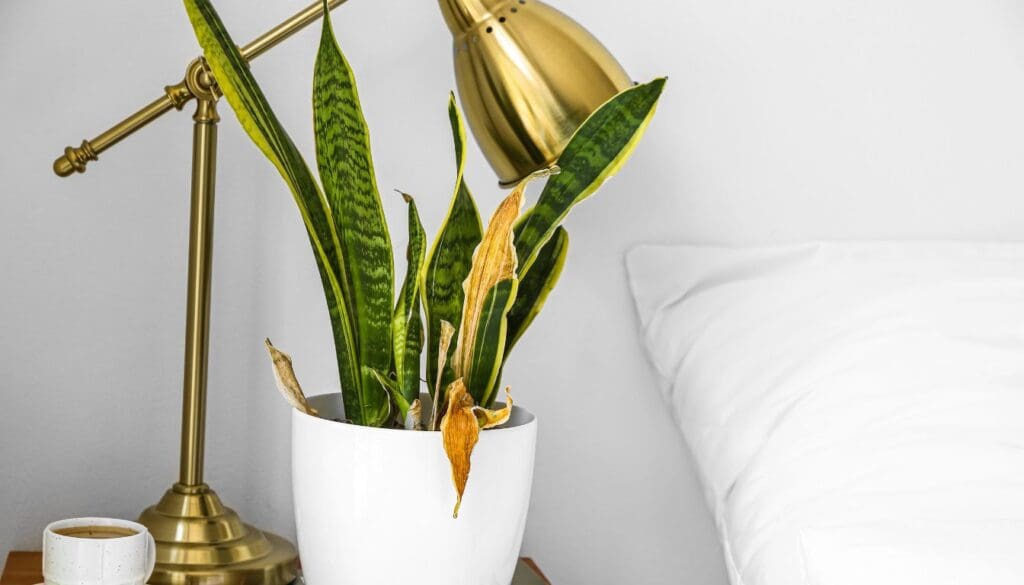
The shade of the leaves tells us a ton about the plant and the strength of the plant.
We may run over yellowing leaves on the Snake Plant and don’t have the foggiest idea what may have caused it.
Yellowing leaves on the Snake plants are a few indications of underwatering the plant. It may happen that the plant has not been watered because you were not accessible.
It is usual for one to overlook the watering.
If it is underwatered, the Snake Plant’s young leaves start to turn yellow and might kill the plant slowly.
Since the plant can’t suck up enough water supplements, the plant begins to shed its leaves to keep the photosynthesis running.
For this, we always recommend removing the yellow leaves off the plant as the leaves will only cause a burden for the plant now.
Another purpose behind the changing shade of the leaves is overfertilization.
Never add additional supplements to the soil. Less is better for this situation.
Light assumes a similar function in the changing shade of the leaves on the Snake plant. We currently realize that the Snake plant requires bright to medium daylight.
Another reason for the yellowing leaves on the Snake Plant could be spider mites or mealybugs.
Indeed, you heard that right. It is unprecedented for a Snake Plant to have any illness. However, if we see any such issue, it could be the pests.
For the pests, new leaves resemble dessert. They feed on the new leaves of the snake plant first.
During the winters, this succulent might develop specific issues.
For example, we need to avoid the southern window from where we will get the cold draft, causing the leaves to turn yellow and wilt the plant.
Keeping the plant near a radiator might also cause issues to the plant.
Lastly, if the plant is kept in a jar containing water, then consider changing the water frequently.
Changing the water frequently helps the plant to suck up the required amount of nutrients from the water.
Also read: How much light do snake plant need?
Root Rot

The Snake plant is most vulnerable to a root rot situation. It generally happens in the winters.
During the winters, this plant requires significantly less watering as it is a succulent. Hence, overwatering might cause root rot.
To check for a root rot situation, we will need to check the soil first.
If the soil is soggy, go for the roots.
Pull out the plant and check the color of the roots.
The roots should be white and crusty instead of black or brown with tender roots. Black or brown, tender roots indicate a root rot situation.
We should always keep a plant in a pot with drainage holes so that the excess water is flushed out of the hole.
If the plant is made to stand on still water, higher is the chance for root rot.
It is suggested to remove the roots that have given up on you. Root trimming might be a way to get the plant back to life.
However, if the root trimming technique does not work, read below to understand the steps on how to revive the plant.
How do you revive the Snake Plant?
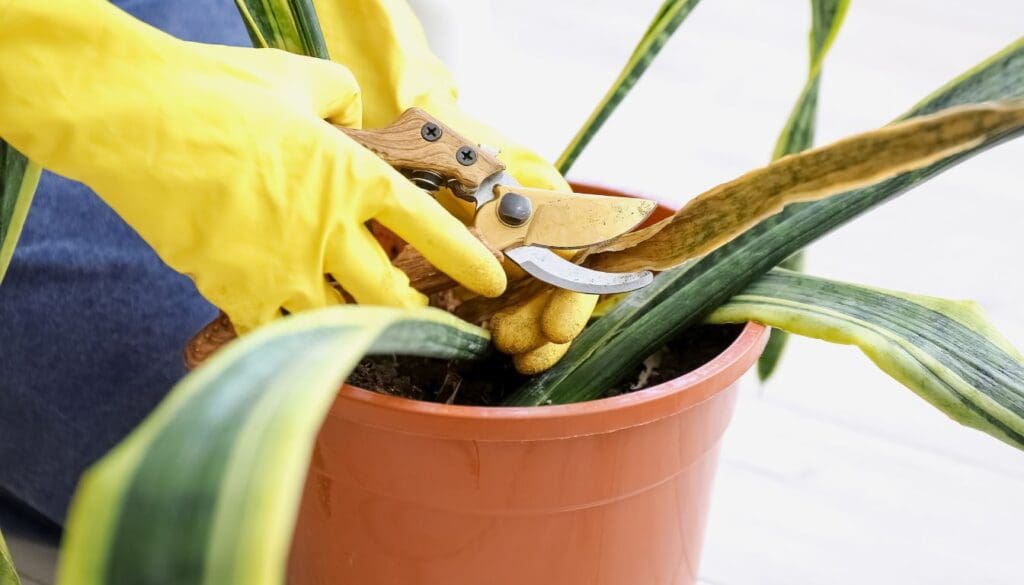
At this point, we comprehend what can turn out badly on account of the Snake Plants. As discussed earlier, it could be the watering issue, or the fertilization issue, or root rot.
These three are the most well-known elements where we can turn out badly on account of the Snake plant.
To conquer this freshman error, we first begin with the watering.
Preparing an organizer for the consideration of the plant is an insightful decision.
We can make a determined watering regime on the Snake Plant by keeping a note or adding it to the schedule.
The Snake plant water requirements are minimal, wherein we need to add water only when the topsoil of about 2-4 inches dries out completely.
During the winters, these succulents can last without water for about 1-2 months.
Along these lines, to defeat some other watering issue, we should Feel the soil before watering the plant.
The soil ought to be dry before we water the plant and not wet. If the soil is wet, we can leave the plant and water it following several days.
Use perlite and soil blend for the Snake plants. Perlite assists with making excellent air circulation in the soil and will maintain the drainage.
It is never proposed to add any fertilizer to the plant throughout the colder time of year as it isn’t the developing season, and the plant is dormant.
We should reduce fertilizer use around the fall and should not add any fertilizer during the winter.
In the developing season and with the right treatment measure, we will see our snake plants develop savagely.
Remember, every one of these elements on the off chance that you don’t perceive any signs. However, if the plant is abandoning you, take a stab at repotting the plant to another pot.
Fill it with a combination of soil and perlite and some fertilizer and take a stab at repotting the snake plant.
The repotting may set aside some effort for the roots to create in the new pot. Deal with the watering, and the plant ought to flourish.
What to do if your Snake Plant is dying?
Even after all the efforts, we see that the effort used goes in vain. Else we want more plants from what we have. It is always wise to propagate the plant.
All of us have queries like will the Snake Plant survive in water, or can it be propagated, and so on.
Let us get right into it and try to get the queries resolved.
Can propagating or repotting save dying Snake Plant?
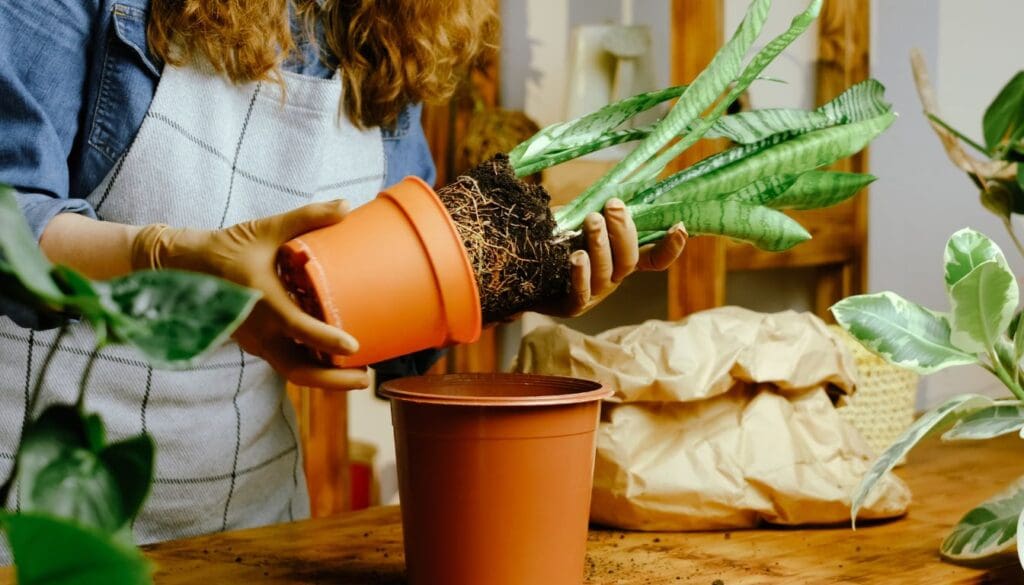
As examined before, these succulents are exceptionally simple to develop and spread. The snake plant can likewise be spread from the cutting of the entire leaves.
All we require for the cutting of the leaves is the white segment beneath the leaf. We need not cut from the rhizome. Simply take the spotless pruners and cut the leaf from the base.
Cut around a few leaves for the cycle as the entirety of the leaves probably won’t get by during the cycle.
We have two choices once we have the entire leaves. We can take the entire leaves and keep it in a holder loaded up with water or decide to pot the entire leaves in soil.
It is your decision on how you need to do it. If you are fretful, I propose saving the entire leaf in the water for a long time until it creates roots, and afterward, we can move.
For keeping the leaf in water, first, take a jar and fill it with water. Keep the leaf cuttings and spot them inside.
Following 2-3 weeks, we will see little roots creating from the lower part of the leaves.
As referenced before, these plants are inclined to root decay, so if there is any root decay, simply cut off the leaf’s finish that has root decay.
Remember to change the water each week, as the compartment may develop algae.
Likewise, plants suck up supplements from the water, so changing water gives the right supplements.
Once the roots have developed, remove the leaves from the water, and plant it into the soil.
We can legitimately keep the leaf cuttings into the soil without keeping them in water first.
In any case, the entire leaf slicing will develop to frame another Snake plant.
These plants are okay to extraordinary temperatures and atmospheric conditions.
Take a pot, fill it with a combination of garden soil and cactus plant soil in a 50:50 proportion, or we can take three pieces of gardening soil and one piece of vermicompost for the cycle. Make sure to add some coarse sand or perlite for aeration.
Take the entire leaf and plant it into the pot. Taking numerous leaves will help us planting various plants as all the leaves probably won’t endure the cycle.
After the leaves are planted into their individual pots, water them to the edge unexpectedly and from the following water shrewdly.
Throughout the late spring, water these plants once per week, and during winters, they ought to go for a month without water.
If we follow this process, we might be able to bring back our plants from the dead and give it one last chance of survival.
Good luck with your Snake Plant, and happy gardening!

Source: The University of Arkansas Division of Agriculture, Snake plant profile.
Recommended Garden Supplies
| Product Image | Our Recommended Gardening Supplies | Check Offers! |
|---|---|---|
Top Top
Top
Top
Top
Top
Top
Top
Top | rePotme Houseplant and Tropical Classic Potting Soil Mix | Check Offer On Amazon |
 Top
Top
Top
Top
Top
Top
Top
Top | Espoma Organic Indoor Plant Food | Check Offer On Amazon |
 Top
Top
Top
Top
Top
Top
Top
Top | GooingTop LED Grow Light 6000K Full Spectrum Clip Plant Growing Lamp | Check Offer On Amazon |
 Top
Top
Top
Top
Top
Top
Top
Top | Soil Moisture Meter | Check Offer On Amazon |
 Top
Top
Top
Top
Top
Top
Top
Top | Govee Hygrometer Thermometer, Bluetooth Enabled! | Check Offer On Amazon |
 Top
Top | LEVOIT Humidifiers for Large Room(Best For Plants) | Check Offer On Amazon |
 Top
Top
Top
Top
Top
Top
Top
Top | Upgraded DIY Automatic Drip Irrigation Kit, 15 Potted Houseplants Support | Check Offer On Amazon |
 Top
Top
Top
Top
Top
Top
Top
Top | Stainless Steel Heavy Duty Gardening Tool Set | Check Offer On Amazon |
 Top
Top
Top
Top
Top
Top
Top
Top | Bonide Insecticidal Soap | Check Offer On Amazon |
 Top
Top
Top
Top
Top
Top
Top
Top | Bonide 32 oz Spray Neem Oil for Organic Gardening | Check Offer On Amazon |
 Top
Top
Top
Top
Top
Top
Top
Top | Garden Safe Fungicide | Check Offer On Amazon |



